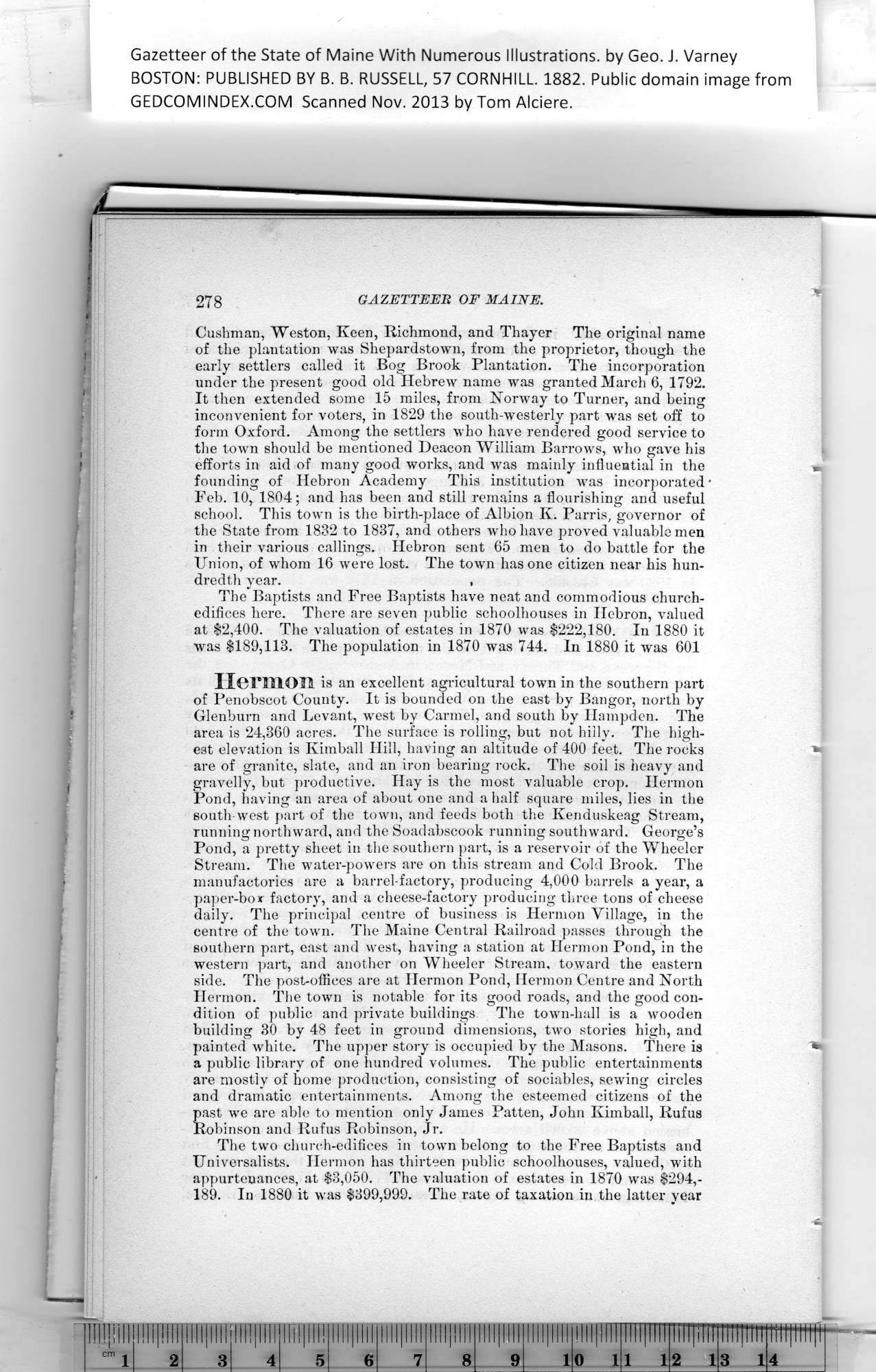|
Gazetteer of the State of Maine With Numerous Illustrations, by Geo. J. Varney
BOSTON: PUBLISHED BY B. B. RUSSELL, 57 CORNHILL. 1882. Public domain image from
Cushman, Weston, Keen, Richmond, and Thayer The original name
of the plantation was Shepardstown, from the proprietor, though the
early settlers called it Bog Brook Plantation. The incorporation
under the present good old Hebrew name was granted March 6, 1792.
It then extended some 15 miles, from Norway to Turner, and being
inconvenient for voters, in 1829 the south-westerly part was set off to
form Oxford. Among the settlers who have rendered good service to
the town should be mentioned Deacon William Barrows, who gave his
efforts in aid of many good works, and was mainly influential in the
founding of Hebron Academy This institution was incorporated
Feb. 10, 1804; and has been and still remains a flourishing and useful
school. This town is the birth-place of Albion K. Parris, governor of
the State from 1882 to 1837, and others who have proved valuable men
in their various callings. Hebron sent 65 men to do battle for the
Union, of whom 16 were lost. The town has one citizen near his hun-
dredth year. ,
The Baptists and Free Baptists have neat and commodious church-
edifices here. There are seven public schoolhouses in Hebron, valued
at $2,400. The valuation of estates in 1870 was $222,180. In 1880 it
was $189,113. The population in 1870 was 744. In 1880 it was 601
Hermon is an excellent agricultural town in the southern part
of Penobscot County. It is bounded on the east by Bangor, north by
Glenburn and Levant, west by Carmel, and south by Hampden. The
area is 24,360 acres. The surface is rolling, but not hilly. The high-
est elevation is Kimball Hill, having an altitude of 400 feet. The rocks
are of granite, slate, and an iron bearing rock. The soil is heavy and
gravelly, but productive. Hay is the most valuable crop. Hermon
Pond, having an area of about one and a half square miles, lies in the
south-west part of the town, and feeds both the Kenduskeag Stream,
running northward, and the Soadabscook running southward. George’s
Pond, a pretty sheet in the southern part, is a reservoir of the Wheeler
Stream. The water-powers are on this stream and Cold Brook. The
manufactories are a barrel-factory, producing 4,000 barrels a year, a
paper-boT factory, and a cheese-factory producing three tons of cheese
daily. The principal centre of business is Hermon Village, in the
centre of the town. The Maine Central Railroad passes through the
southern part, east and west, having a station at Hermon Pond, in the
western part, and another on Wheeler Stream, toward the eastern
side. The post-offices are at Hermon Pond, Hermon Centre and North
Hermon. The town is notable for its good roads, and the good con-
dition of public and private buildings The town-liall is a wooden
building 30 by 48 feet in ground dimensions, two stories high, and
painted white. The upper story is occupied by the Masons. There is
a public library of one hundred volumes. The public entertainments
are mostly of home production, consisting of sociables, sewing circles
and dramatic entertainments. Among the esteemed citizens of the
past we are able to mention only James Patten, John Kimball, Rufus
Robinson and Rufus Robinson, Jr.
The two church-edifices in town belong to the Free Baptists and
Universalists. Hermon has thirteen public schoolhouses, valued, with
appurtenances, at $3,050. The valuation of estates in 1870 was $294,-
189. In 1880 it was $399,999. The rate of taxation in the latter year
PREVIOUS PAGE ... NEXT PAGE
This page was written in HTML using a program written in Python 3.2
|
